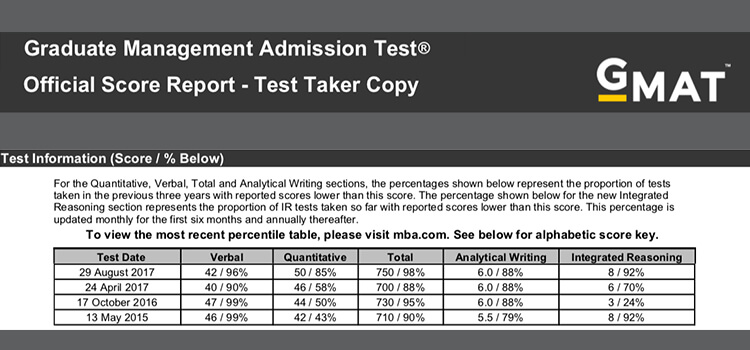How To Prepare For Your GMAT Examination
The Graduate Management Admission Test (commonly called as GMAT) is a standardized computer adaptive exam to assess your analytical, writing, quantitative, verbal, and reading skills in written English. The assessment result is further used in admission decisions by 5000+ graduate management programs all over the world. Essentially, the GMAT helps you put forth your academic potential for success in these management programs.
So here, I shall talk about everything about GMAT examination. Be it the exam structure, or tips for prepping for the test. Let’s get started.
EXAM & SCORING STRUCTURE
The GMAT comprises of four sections, namely – Analytical Writing Assessment (AWA), Verbal, Quants, and Integral Reasoning (IR). The verbal and quant sections have different sub-topics to be covered in contrast to the analytical writing and integrated reasoning sections! But there are some tiny points one must keep in mind while attempting the AWA and IR sections. We shall talk about each section in-depth in a short while.
Now, before one attempts the GMAT, one needs to understand the scoring structure as well. Different management/business schools look at GMAT scores differently. Basically, the GMAT score sheet has the following scores:
- Quant Score (out of 51)
- Verbal Score (out of 51)
- Analytical Writing Assessment Score (out of 6)
- Integrated Reasoning Score (out of 8)
The combined verbal and quant scores are further extrapolated by an algorithm set by GMAC (Graduate Management Admission Council) in the range of 200-800. The algorithm takes several things into account while extrapolating these scores, few of them being – number of questions answered, number of questions answered correctly, level of difficulty attained, etc. Since GMAT is an adaptive test, the greater number of questions you answer correctly, the more difficult questions you get subsequently and vice-versa.

The GMAT scoresheet will also include a percentile, comparing your performance or skill level with other test takers in the past three years.
Now, that we have understood the basic scoring structure of the test, we can now dive into each individual section!
INDIVIDUAL SECTION #1 - QUANTS
To give you the crux – you will have precisely 62 minutes to solve 31 mathematical problems (In 2016, it was 75 minutes and 37 questions). That is, you shall have only 120 seconds to solve each problem. Now there are many math wizards, who might think that its a child’s play! But be warned, it is not that straightforward. Remember, with each correct answer you will get a more difficult question. Many engineers may find it easy to score a 47 or even a 48 out of 51. But scoring 50 or 51 makes an enormous impact on your overall score out of 800.
There are several topics that get covered in the quants section. These topics are again categorized into 2 broad question types – i.e. Problem Solving (consisting of 18-20 questions) and Data Sufficiency (consisting of 11-13 questions). To further elaborate, problem solving questions involve a general problem statement having a single correct answer among the 5 choices given. For example,
Q. If n is the product of the integers from 1 to 8, inclusive, how many different prime factors greater than 1 does n have?
- 4
- 5
- 6
- 7
- 8
On the contrary, data sufficiency questions involve a problem and two factual statements, labelled (1) and (2), containing certain data. Now, we have to determine (with our math knowledge) whether the data provided in statement 1 or 2 is sufficient to correctly answer the problem given. For example,
Q. Is x>y?
1) x = y +2
2) x/2 = y - 1
- Statement (1) ALONE is sufficient, but statement (2) alone is not sufficient
- Statement (2) ALONE is sufficient, but statement (1) alone is not sufficient
- EACH statement ALONE is sufficient
- Statements (1) and (2) TOGETHER are not sufficient

So, these are the only 2 question types that test your quants aptitude. Nonetheless, these 2 types of questions test you on various topics. Topics covered are namely - Arithmetic, Algebra, and Geometry.
- Arithmetic
- Algebra
- Geometry
Multiples and Factors, Number Properties, Fractions, Decimals, Percentage, Power and Roots, Average, Probability, Set Theory, Mixtures and Allegations, Ratios and Proportions, Descriptive Statistic Analysis, Speed-Time-Distance, Simple and Compound Interest.
Monomials, Polynomials, Functions, Exponents, Quadratic Equations, Inequalities, Expressions and Equations, Permutation and Combination, Arithmetic and Geometric Progression.
Triangle, Lines and Angles, Quadilaterals, Circles, Cylinders, Cones, and Coordinate Geometry.
Now, the biggest question arises – HOW TO SCORE A 50+ IN QUANTS SECTION
Honestly, one needs to have a good grasp of all concepts. Practice is the key. Time management is even more important. There are questions, which are seemingly simple but demand a significant amount of time (which you cannot afford). There are little tricks for various types of questions that come in handy while solving such type of questions! Explore these tricks here.
One needs to understand that scoring a 50 or a 51 does not mean answering all questions correctly. In fact, one needs to maintain consistency in answering questions correctly. What I mean is, the high(s) of your skill/aptitude level graph should not variate much, while answering questions.
INDIVIDUAL SECTION #2 - VERBAL
In this section, you will have precisely 65 minutes to solve 36 questions (In 2016, it was 75 minutes and 41 questions). So, you have 1.8 minutes, i.e. 110 seconds to solve each question. I, personally, had a tough time coping up with the verbal section. The verbal section is further categorized into 3 question types – Reading Comprehension, Critical Reasoning, and Sentence Correction.


Reading Comprehension, as the name suggests, consists of a short/long paragraph (200-400 words) and associated 3-4 multiple choice questions that need to be answered. One might get 3-4 reading comprehension questions in the whole verbal section!
Sentence Correction involves correcting a grammatical error in a given sentence (importantly, without changing the meaning/context). As far as sentence correction question type is concerned, there are various concepts that one needs to grasp. These concepts, or rather grammatical rules, are very different than that of our daily spoken English. Some of these concepts are namely – pronouns, subject-verb agreement, modifiers, idioms, parallelism, comparison, and verb tenses. I, personally, found parallelism and comparison to be extremely important while solving majority of the sentence correction problems.
Last but not the least, Critical Reasoning type questions. I found them to be the most difficult to solve, given the time frame (110 seconds). But over time with practice, I got a hang of solving them with a somewhat average accuracy. In these types of questions, we need to find the most appropriate reasoning for a given argument. There are again sub-types namely – Assumptions, Evaluations, Inferences, Bold Face, Paradox, and Strengthen and Weaken.
The number of questions for sentence correction (SC) and critical reasoning (CR) are fairly equal. There might be 2-3 questions more or less from each category, but that again depends on the GMAC set algorithm.
It is interesting to know, that a score of 40+ in verbal is considered to be really good! Now, how to achieve that ideal score?
The strategy is fairly simple to understand, but simultaneously very difficult to implement. Again, one needs to maintain a certain level of consistency while answering questions. But there are some specific tips that I would like to share!
For sentence correction, one needs to focus more on the logic and meaning of the sentence. One word here and there can change the entire meaning of the sentence! So, one needs to be very careful there. Once the meaning is identified, then it becomes easy to use the elimination strategy to rule out the wrong answers. At least, that is what I did when I took my exam in 2016.
For reading comprehension, there are majorly two strategies one can adapt. First being reading the questions before the given paragraph. Second being reading the given paragraph before the questions. These two strategies work differently with different people. The first strategy worked out pretty well for me, as I knew what I was looking for in the paragraph.
Now, comes the devil! (at least for me) Critical reasoning (CR). It took me a lot of time to develop different approaches for different types of CR questions (as compared to sentence correction and reading comprehension). There are these sub-types, which you NEED to identify to solve them. The only way for me was to practice, day in and day out. I must have practiced over 1000 questions to get a hang of solving critical reasoning questions efficiently. Doing so, I remembered my 11th grade solving countless trigonometry questions (from RD Sharma) just to identify various types of questions.
INDIVIDUAL SECTION #3 – INTEGRATED REASONING (IR)
This section consists of 12 question and a time-frame of 30 min. This section is fairly easy as compared to other sections. Perhaps the easiest. This section also has different types of questions, namely – Multi Source Reasoning, Table Analysis, Graphical Interpretation, and Two-Part Analysis. Integrated reasoning essentially tests your data analysis skills.
To make it a little easy for you guys, let me just describe each type of question, which will make your life much easier. Trust me, you don’t need to bang your head against the wall for this section.
- Multi Source Reasoning
- Table Analysis
- Graphical Interpretation
- Two-Part Analysis
More like critical reasoning questions, but with data split into different tabs. You need to collate useful information from these different tabs and arrive at a conclusive answer.
This is like any other stats question, where in a data table is provided and you get to solve 3-4 questions pertaining to that data.
Another visualization-based question. The data can be presented via various pictorial forms – bar graphs, box-plot, histograms, pie charts, etc. You just have to interpret the data correctly and answer the questions.
In this for a given paragraph full of information, you will need to find answers to two questions that are somehow related to each other.
Again, if you manage your time well here, you might even get some time to revise your answer choices!
INDIVIDUAL SECTION #4 – ANALYTICAL WRITING ASSESSMENT (AWA)
So, for most of us, who are not already aware of the GMAT test structure, this might be the most overrated section in terms of time, creativity, and what not! But let me be very clear about this section – this is just another critical reasoning question! Yes, you heard it right.
You just have to jot down your reasoning in an essay format for the argument given! And you have 30 minutes for that. It’s always better to practice at least 3-5 questions in your mocks and work out a template that you can follow on the day of your test. It helps a lot!
ESSENTIAL TIPS AND RESOURCES
Now, let’s talk about some FAQs that might come in handy whilst you prepare for your GMAT examination. A lot of prospective GMAT candidates seek answers to such similar questions (apart from GMAT structure, scoring, and syllabus).
Q1. Should I start prepping myself, or should I seek a professional tuition?
It totally depends on you, your current profession, and score submission deadline (if any). If you do not have a particular deadline for submitting your GMAT scores, you have plenty of time to prep yourself (at least 5-6 months), and you believe that you can chip in at least 2-3 hours each day for your GMAT preparation, then you probably don’t need any professional tuitions. One can always check out online resources and e-books, such as GMAT Prep, Manhattan, E-GMAT, Crack Verbal, PowerScore, The Economist, etc.
But if that's not the case, i.e. you have a 2 or a 3 month deadline to submit your scores to a particular B-school, you are facing difficulty grasping key concepts, you are not able to improve your score from 640-660 to 700+, or maybe you are not motivated enough to do it all by yourself, YOU NEED A GOOD GMAT INSTRUCTOR. And trust me when I say - finding a good GMAT instructor is not easy!
I was very lucky to have found my ideal GMAT guru in a very short span of time. I had a 94-day deadline for my ISB stage 2 application submission, and it was a do or die situation for me. In addition, I also pursued my 6-week technical internship at HCL Infosystems during these 94 days! Quite literally, I was up for a scary roller coaster ride.
But all credit to Mr. Devender (from Tathastu Education), I took one-to-one crash course for 35 days (2 hour session almost every day). And then I took upon myself to repeatedly brush up my concepts, take mock tests, learn from my mistakes for the remaining days (approx. 60 days).
Q2. What is a proper method to take/attempt mock tests?
The idea is to replicate the GMAT exam center atmosphere. First of all, you need to stick to the same section order (AWA, IR, Quants, and Verbal) whatever you decide. It can be anything that suits you the best. Second, it is very important to time your mocks. One should time each section, and take timely breaks (as allowed in an actual GMAT examination).
After completing each mock, it is imperative to review your mistakes and jot down them in an error log book. This error log book helps you to review and learn from your mistakes in a very short period of time.
Q3. What to do before the D-Day?
It is recommended to just STOP everything (hibernate) related to GMAT 5-6 days before the exam date. Trust me, it helps a lot!
SOME MORE TIPS
- It might take more than 1 attempt to crack the exam. There is a very small proportion of test takers scoring a 700+ in the first attempt. So, don’t worry!
- Low scores do not mean that you won’t get admission in your desired business school. It is only one of the criteria that contributes to your whole profile. If your overall profile is nice, you might just get an admission offer with a mere 640 as well!
- Some questions are repeated exactly from the question bank from the GMAT official guides. So make sure to practice questions from the current and previous five years' official guides.
- Take a free GMAT assessment before you start your preparations. It is always better to assess your current skill levels and improve on your weak areas.
- It is easy to cross the 640-650 barrier; the real deal starts when you need to cross the 700 mark. The key is to practice and to learn from previous mistakes.
- Buy GMAT Prep tests! They offer the most relevant test experience to the test takers.
- Take Manhattan tests, if you want to score a 50 or 51 in the quants section. The quants problems in Manhattan tests are generally a little more difficult and time consuming. So when you start scoring a decent score in the Manhattan quants, you start getting more confident about nailing the GMAT quants section!
- Practice, Practice, and Practice – This is the only mantra for cracking GMAT.
So, that was it! I hope that you found this article insightful. And I wish good luck to all future GMAT aspirants. Do leave a message for any queries. I shall try my level best to address them. Cheers 😊
PS. If you want to start prepping for GMAT as soon as possible, I do have some valuable resources (e-books) up for grabs. These e-books are considered to be the bible for verbal – sentence correction and critical reasoning! Share this article on your social media handles, mail the screenshots to info@thekeshavgoyal.com, and I shall share those resources with you for free! Also, do subscribe my blog newsletter for latest post notifications and announcements.
Leave a Reply